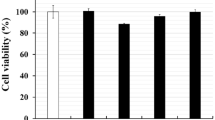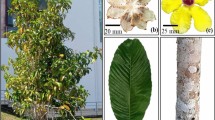Abstract
Background
Coccidiosis is an intestinal disease caused by protozoan parasites of the genus Eimeria and responsible for considerable economic loss in the livestock and poultry industries. Resistance to the current anticoccidial drugs is now a major challenge to efforts to control the disease, and this has stimulated the search for new compounds as alternative treatments. In this context, plant extracts have emerged as an alternative and complementary approach to control coccidiosis. In the present study, an ethanol extract of Moringa oleifera leaves was screened for its anticoccidial activity against Eimeria papillata infection in mice.
Methods
To this end, albino mice were allocated into three groups: the first group was the non-infected control; the second and third groups were infected with 103 E. papillata oocysts. Of these, the second group was kept as an infected control; while the third group was gavaged with 100 μl of moringa leaf extract (MLE) at a dose of 400 mg MLE/kg, once daily, for five days.
Results
MLE significantly suppressed oocyst excretion in faeces, and histological study of the jejunum showed a significant decrease in the number of parasitic stages, with significant improvement in the numbers of goblet cells. Furthermore, the expression of MUC2 gene was upregulated in the treated mice compared with infected, which further supports the anticoccidial potential of MLE. Moreover, our study evidenced that MLE reduced oxidative damage by decreasing TBARS and iNOS expression, and increasing the GSH and GPX levels. Also, treatment with MLE promoted the expression of Bcl-2 and ultimately, inhibited the apoptosis of host cells in the treated mice.
Conclusion
Our data indicate that MLE has anticoccidial, anti-oxidant and anti-apoptotic activities in mice infected with Eimeria papillata.









Similar content being viewed by others
References
El Banna H, Atef M, Nabil G (2016) Anti-coccidial activity of Moringa Oleifera plant. Anim Vet Sci 4:19–25
Alnassan A, Kotsch M, Shehata A, Krüger M, Daugschies A, Bangoura B (2014) Necrotic enteritis in chickens: development of a straightforward disease model system. Vet Rec 174:555. https://doi.org/10.1136/vr.102066
Quiroz-Castañeda R, Dantán-González E (2015) Control of avian coccidiosis: future and present natural alternatives. Biomed Res Int 2015:430610. https://doi.org/10.1155/2015/430610
Metwaly MS, Dkhil MA, Al-Quraishy S (2014) Anti-coccidial and anti-apoptotic activities of palm pollen grains on Eimeria papillata-induced infection in mice. Biologia 69:254–259
Alkhudhayri AA, Dkhil MA, Al-Quraishy S (2018) Nanoselenium prevents eimeriosis-induced inflammation and regulates mucin gene expression in mice jejunum. Int J Nanomed 13:1993. https://doi.org/10.2147/IJN.S162355.eCollection
Chapman H (1997) Biochemical, genetic and applied aspects of drug resistance in Eimeria parasites of the fowl. Avian Pathol 26:221–244
Wunderlich F, Al-Quraishy S, Steinbrenner H, Sies H, Dkhil MA (2014) Towards identifying novel anti-Eimeria agents: trace elements, vitamins, and plant-based natural products. Parasitol Res 113:3547–3556. https://doi.org/10.1007/s00436-014-4101-8
Pop LP, Varga E, Coroian M, Nedișan ME, Mircean V, Dumitrache MO, Farczádi L, Fülöp I, Croitoru MD, Fazakas M (2019) Efficacy of a commercial herbal formula in chicken experimental coccidiosis. Parasites Vectors 12:343
Leone A, Spada A, Battezzati A, Schiraldi A, Aristil J, Bertoli S (2016) Moringa oleifera seeds and oil: characteristics and uses for human health. Int J Mol Sci 17:2141. https://doi.org/10.3390/ijms17122141
Waterman C, Rojas-Silva P, Tumer TB, Kuhn P, Richard AJ, Wicks S, Stephens JM, Wang Z, Mynatt R, Cefalu W, Raskin I (2015) Isothiocyanate-rich Moringa oleifera extract reduces weight gain, insulin resistance, and hepatic gluconeogenesis in mice. Mol Nut Food Res 59(2015):1013–1024. https://doi.org/10.1002/mnfr.201400679
Abd El-Hack ME, Alagawany M, Elrys AS, Desoky EM, Tolba H, Elnahal AS, Elnesr SS, Swelum AA (2018) Effect of forage Moringa oleifera L. (moringa) on animal health and nutrition and its beneficial applications in soil, plants and water purification. Agriculture 8:145
Pandey V, Chauhan V, Pandey V, Upadhyaya P, Kopp OR (2019) Moringa oleifera Lam.: a biofunctional edible plant from India, phytochemistry and medicinal properties. J Plant Stud 8:10–19
Ola-Fadunsin SD, Ademola IO (2013) Direct effects of Moringa oleifera Lam (Moringaceae) acetone leaf extract on broiler chickens naturally infected with Eimeria species. Trop Anim Health Prod 45:1423–1428
Salles HO, Braga AC, Nascimento MT, Sousa AM, Lima AR, Vieira Lda S, Cavalcante AC, Egito AS, Andrade LB (2014) Lectin, hemolysin and protease inhibitors in seed fractions with ovicidal activity against Haemonchus contortus. Rev Bras Parasitol Vet 23:136–143
Abdel-Latif M, El-Shahawi G, Aboelhadid S, Abdel-Tawab H (2018) Modulation of murine intestinal immunity by Moringa oleifera extract in experimental hymenolepiasis nana. J Helminthol 92:142–153
Okechukwu PU, Okwesili FN, Parker EJ, Abubakar B, Emmanuel CO, Christian EO (2013) Phytochemical and acute toxicity studies of Moringa oleifera ethanol leaf extract. Int J Life Sci Biotechnol Pharm Res 2:66–71
Sinha M, Das DK, Datta S, Ghosh S, Dey S (2012) Amelioration of ionizing radiation induced lipid peroxidation in mouse liver by Moringa oleifera Lam. leaf extract. Indian J Exp Biol 50:209
Dkhil M, Abdel-Baki A, Wunderlich F, Sies H, Al-Quraishy S (2011) Anticoccidial and antiinflammatory activity of garlic in murine Eimeria papillata infections. Vet Parasitol 175:66–72
Adam H, Czihak G (1964) Arbeitsmethoden der makroskopischen und mikroskopischen Anatomie: ein Laboratoriumshandbuch für Biologen, Mediziner und technische Hilfskräfte. Gustav Fischer Verlag, Stuttgart
Allen A, Hutton D, Leonard A, Pearson J, Sellers L (1986) The role of mucus in the protection of the gastroduodenal mucosa. Scand J Gastroenterol 21:71–78
Hermes-Uliana C, Frez FCV, Sehaber CC, Ramalho FV, de Souza Neto FP, Cecchini R, Guarnier FA, Zanoni JN (2018) Supplementation with l-glutathione improves oxidative status and reduces protein nitration in myenteric neurons in the jejunum in diabetic Rattus norvegicus. Exp Mol Pathol 104:227–234
Ohkawa H, Ohishi N, Yagi K (1979) Assay for lipid peroxides in animal tissues by thiobarbituric acid reaction. Anal Biochem 95:351–358
Sedlak J, Lindsay RH (1968) Estimation of total, protein-bound, and nonprotein sulfhydryl groups in tissue with Ellman's reagent. Anal Biochem 25:192–205
Kar M, Mishra D (1976) Catalase, peroxidase, and polyphenoloxidase activities during rice leaf senescence. Plant Physiol 57:315–319
Livak KJ, Schmittgen TD (2001) Analysis of relative gene expression data using real-time quantitative PCR and the 2(-Delta Delta C(T)) method. Methods 25:402–408
Yim D, Kang SS, Kim DW, Kim SH, Lillehoj HS, Min W (2011) Protective effects of Aloe vera-based diets in Eimeria maxima-infected broiler chickens. Exp Parasitol 127:322–325
Habibi H, Firouzi S, Nili H, Razavi M, Asadi SL, Daneshi S (2016) Anticoccidial effects of herbal extracts on Eimeria tenella infection in broiler chickens: in vitro and in vivo study. J Parasit Dis 40:401–407. https://doi.org/10.1007/s12639-014-0517-4
Linh BK, Hayashi T, Horii Y (2009) Eimeria vermiformis infection reduces goblet cells by multiplication in the crypt cells of the small intestine of C57BL/6 mice. Parasitol Res 104:789–794
Khan W, Collins S (2004) Immune-mediated alteration in gut physiology and its role in host defence in nematode infection. Parasite Immunol 26:319–326
Ishiwata K, Watanabe N (2007) Nippostrongylus brasiliensis: reversibility of reduced-energy status associated with the course of expulsion from the small intestine in rats. Exp Parasitol 117:80–86
Abdel-Latif M, Abdel-Haleem HM, Abdel-Baki AS (2016) Anticoccidial activities of chitosan on Eimeria papillata-infected mice. Parasitol Res 115:2845–2852. https://doi.org/10.1007/s00436-016-5035-0
Ishikawa N, Horii Y, Nawa Y (1993) Immune-mediated alteration of the terminal sugars of goblet cell mucins in the small intestine of Nippostrongylus brasiliensis-infected rats. Immunology 78:303
Pelaseyed T, Bergström JH, Gustafsson JK, Ermund A, Birchenough GM, Schütte A, van der Post S, Svensson F, Rodríguez-Piñeiro AM, Nyström EE, Wising C, Johansson ME, Hansson GC (2014) The mucus and mucins of the goblet cells and enterocytes provide the first defense line of the gastrointestinal tract and interact with the immune system. Immunol Rev 260:8–20. https://doi.org/10.1111/imr.12182
Dkhil MA, Thagfan FA, Hassan AS, Al-Shaebi EM, Abdel-Gaber R, Al-Quraishy S (2019) Anthelmintic, anticoccidial and antioxidant activity of Salvadora persica root extracts. Saudi J Biol Sci 26:1223–1226. https://doi.org/10.1016/j.sjbs.2019.02.006
Luqman S, Srivastava S, Kumar R, Maurya AK, Chanda D (2012) Experimental assessment of Moringa oleifera leaf and fruit for its antistress, antioxidant, and scavenging potential using in vitro and in vivo assays. Evid Based Complement Alternat Med 2012:519084. https://doi.org/10.1155/2012/519084
Green DR (2004) Apoptotic pathways: paper wraps stone blunts scissors. Cell 102:1–4
Fisch S, Gray S, Heymans S, Haldar SM, Wang B, Pfister O, Cui L, Kumar A, Lin Z, Sen-Banerjee S, Das H, Petersen CA, Mende U, Burleigh BA, Zhu Y, Pinto YM, Liao R, Jain MK (2007) Kruppel-like factor 15 is a regulator of cardiomyocyte hypertrophy. Proc Natl Acad Sci 104:7074–7079
Jannah M, Subagyo DTL, Nasihun T (2017) The effect of Moringa oleifera Lam. leaf extract on Bcl2 and Bax expression in paracetamol-induced renal tubular apoptosis in rats. J Med Health 8:61–67
Abdel-Haleem HM, Aboelhadid SM, Sakran T, El-Shahawy G, El-Fayoumi H, Al-Quraishy S, Abdel-Baki AS (2017) Gene expression, oxidative stress and apoptotic changes in rabbit ileum experimentally infected with Eimeria intestinalis. Folia Parasitol 64:1–12
Jaiswal D, Rai PK, Mehta S, Chatterji S, Shukla S, Rai DK, Sharma G, Sharma B, Khair S, Watal G (2013) Role of Moringa oleifera in regulation of diabetes-induced oxidative stress. Asian Pac J Trop Med 6:426–432
Acknowledgements
This work was supported by Researcher supporting Project (RSP-2019/3), King Saud University.
Author information
Authors and Affiliations
Corresponding author
Ethics declarations
Conflict of interest
The authors declare that they have no conflicts of interest.
Additional information
Publisher's Note
Springer Nature remains neutral with regard to jurisdictional claims in published maps and institutional affiliations.
Rights and permissions
About this article
Cite this article
Abdel-Tawab, H., Abdel-Haleem, H.M., Abdel-Baki, AA.S. et al. Anticoccidial and Antioxidant Activities of Moringa oleifera Leaf Extract on Murine Intestinal Eimeriosis. Acta Parasit. 65, 823–830 (2020). https://doi.org/10.2478/s11686-020-00219-w
Received:
Accepted:
Published:
Issue Date:
DOI: https://doi.org/10.2478/s11686-020-00219-w




